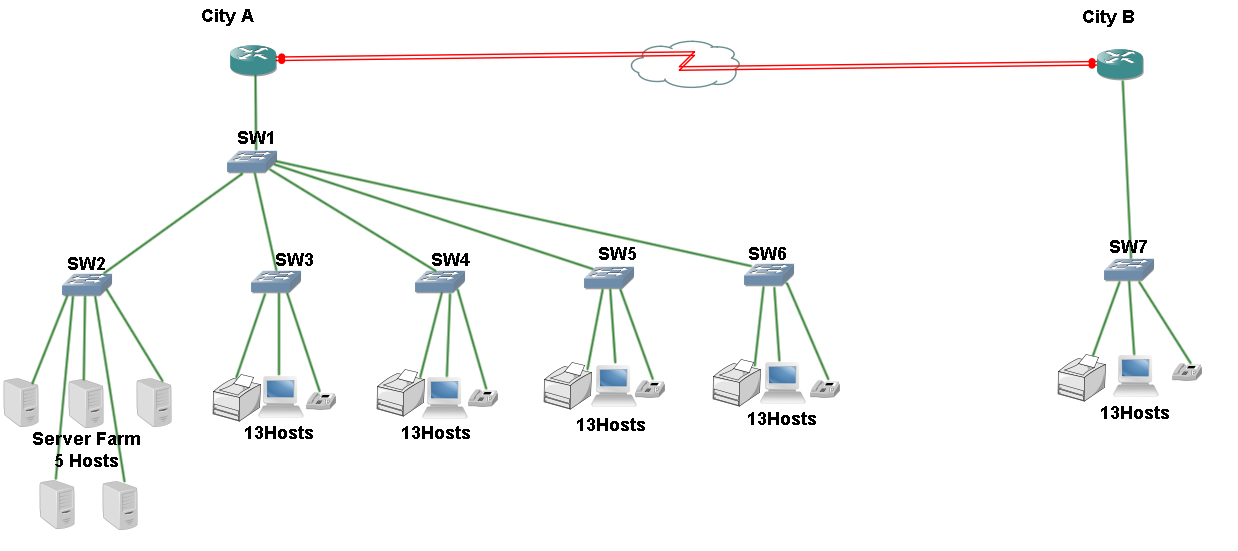- Cisco Community
- Technology and Support
- Networking
- Other Network Architecture Subjects
- IP Adressing and subnetting for small company
- Subscribe to RSS Feed
- Mark Topic as New
- Mark Topic as Read
- Float this Topic for Current User
- Bookmark
- Subscribe
- Mute
- Printer Friendly Page
IP Adressing and subnetting for small company
- Mark as New
- Bookmark
- Subscribe
- Mute
- Subscribe to RSS Feed
- Permalink
- Report Inappropriate Content
05-17-2012 05:57 AM - edited 03-03-2019 06:35 AM
Hey everybody. I'm trying to come up with the best solution for this topology. The descryption is as follows:
A small company with 50PCs, 10Printers, 5Web Servers and 5 IP phones is functioning in two places. City A - the main branch and City B.
Now I would like to know how should I do this. According to my friend the servers should have their own static IP. Each of the host PC on this screenshot represents actually 10PCs and each printer stands for two. Also the subnetting should be ready for growth of the company so there should be some extra slots or even segments. I've read the guide to this at http://www.cisco.com/en/US/tech/tk365/technologies_tech_note09186a00800a67f5.shtml, but I still don't understand how should it be done when there is one more switch standing on top of the other subnets.

Now, I can choose any IPs I want and any class I want.. it't just an exercise so, if you guys here can, and are willing, please tell me how should this be properly done.
Thanks.
- Labels:
-
Other Networking
- Mark as New
- Bookmark
- Subscribe
- Mute
- Subscribe to RSS Feed
- Permalink
- Report Inappropriate Content
05-17-2012 07:06 AM
Hi,
I am not very good design expert but let me just share what I have in my mind.
1/ Use different address space for links between Switch-router and router-router : /28 will be sufficient (or /27 if consider future growth)
2/ Use another address space for manaement of switch and router (/28 is sufficient)
3/ Use atleast /24 for hosts considering future growth and this should be separate address space too.
4/ Use different address space (atleast /28) for printers
Hope this helps
Regards # Mahesh
- Mark as New
- Bookmark
- Subscribe
- Mute
- Subscribe to RSS Feed
- Permalink
- Report Inappropriate Content
05-17-2012 10:38 PM
Jonathan Statham wrote:
Hey everybody. I'm trying to come up with the best solution for this topology. The descryption is as follows:
A small company with 50PCs, 10Printers, 5Web Servers and 5 IP phones is functioning in two places. City A - the main branch and City B.
Now I would like to know how should I do this. According to my friend the servers should have their own static IP. Each of the host PC on this screenshot represents actually 10PCs and each printer stands for two. Also the subnetting should be ready for growth of the company so there should be some extra slots or even segments. I've read the guide to this at http://www.cisco.com/en/US/tech/tk365/technologies_tech_note09186a00800a67f5.shtml, but I still don't understand how should it be done when there is one more switch standing on top of the other subnets.
Now, I can choose any IPs I want and any class I want.. it't just an exercise so, if you guys here can, and are willing, please tell me how should this be properly done.
Thanks.
The first question I have is - are your switches layer 3 capable, or just layer 2?
I would have each segment in a separate VLAN, with a /24 for IP space, then trunk the VLAN's back to switch 1 (if it's layer 3 capable), or through switch 1 to the router, making switch 1 the "distribution" switch and the router your "core".
Use a /30 for your intra-site link (no need for more - it's a point-to-point link - and use another /24 for Site 2.
Make sure your routers have clear routes configured to link all the subnets, and away you go. Separate VLAN's to reduce broadcast domains, nice little islands of PC's and printers, and logical separation.
If *all* your switches are Layer 3 capable, you could be more complex and setup each switch with SVI's for your connected devices, and then use another SVI (or no switchport option on your uplink port) to connect them - but that'd be messy, and you'd end up having a to put a routing table on all devices which you really don't need.
Cheers.
Discover and save your favorite ideas. Come back to expert answers, step-by-step guides, recent topics, and more.
New here? Get started with these tips. How to use Community New member guide
